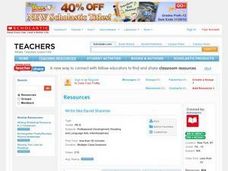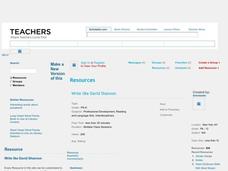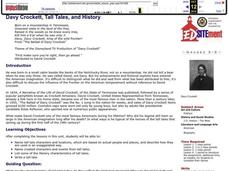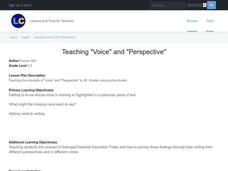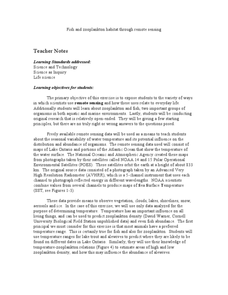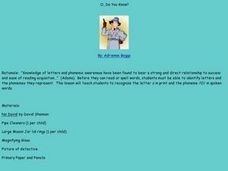Curated OER
Write like David Shannon
Students distinguish various books by David Shannon from other authors, compare three of Shannon's books for similarities, list various possible settings for stories, integrate Shannon's pattern of writing into their own, and formulate...
Curated OER
Ain't Gonna Rain No More
In this creative writing instructional activity, pupils listen to the song "It Ain't Gonna Rain No More", read the book adaptation titled I Ain't Gonna Paint No More!, and pay close attention to the rhyming scheme, punctuation and...
Curated OER
Lesson 2: Feelings
After reading the story, David, No! and creating a chart of David's feelings, youngsters discuss how they knew how he felt throughout the story. They discuss using prior knowledge and picture clues to determine how the main...
Curated OER
No is No, Si is Yes
Third graders match the body part words in Spanish to a picture. They receive a picture of a human with lines coming from its feet, hands, and arms. Students use a word bank, to write the Spanish word that corresponds to the picture. ...
Curated OER
Lesson 3: Looks, Actions, and Feelings
Remember that boy David from the David, No! books? He's back, and youngsters draw a picture of him from a scene in the book David Goes to School. They write a sentence describing his appearance, actions, and feelings...
Curated OER
Write Like David Shannon
Students listen to several of David Shannon's books and identify patterns in the text. They write and illustrate a story of their own in the style of David Shannon, and share their books with classmates.
Curated OER
Write Like David Shannon
Students research the author David Shannon. In this author study lesson, students discuss their favorite David Shannon book and write their own story using his style of writing. Students share their stories with their classmates.
Curated OER
Stewart's Boxes
Learners collect memorabilia and create shadow boxes in the style of David Stewart. They also compose a poem and explain their identity in an oral presentation. This is a rare instructional activity that works quite well for a variety of...
Curated OER
What Do We Owe To Thoreau?
Students use this design as an electronic reading and writing guide to Henry David Thoreau's famous essay, "On Civil Disobedience." They use activities to familiarize students with the political issues of Thoreau's time. Comprehension...
Curated OER
Using Children's Literature to Teach Writing: No, David!
Students review beginning, middle, and end of a story and how details add to a story.
Curated OER
Finding Comfort in an Unfamiliar Landscape
Students recognize the writings of a prominent American writer. They analyze written text making connections to personal prior experience. Students discuss in small and large groups their findings. They organize ideas in writing using...
Curated OER
Born on a Mountaintop? Davy Crockett, Tall Tales, and History
Students compare and contrast the details from the life of the real David Crockett and the legendary folk hero he later became. They identify the characteristics of a tall tale and follow a rubric to create a tall tale of their own.
Curated OER
Debates on Persuasive Language That Extend Outside of Class
There is no better sight to see than a classroom full of eager young adults, hands raised high, eager to jump into a class discussion. Get your class identifying and discussing rhetorical strategies and then debating long into the night...
Curated OER
Ohhhh Me, Ohhhhh My!
Students practice identifying phonemes and recognizing letters in written words to become fluent readers. They study the phoneme /O/ in the tongue twister, "Oh No, my Nose needs an operation in October." Each student also interacts with...
Curated OER
Perspective
Students explore the writing trait of voice. In this writing skills lesson plan, students read No, David! and discuss the author's use of voice. Students write a class version of the story called Yes, David! that incorporates an...
Curated OER
Fish and Zooplankton Through Remote Sensing
Ecology aces examine sea surface temperature maps and relate temperatures to concentration in fish and zooplankton populations. Take your class to a computer lab and provide experience with actual remote sensing data. Some of the links...
PBS
Using Primary Sources: Wide Open Town
A picture speaks a thousand words, no matter how old! Scholars use political cartoons from the era of Prohibition and the Temperance Movement to analyze what, a primary document (in this case, a bootlegger's notebook) is telling them...
Curated OER
Lesson 1: Actions
Action is what characters in books do or say. Little ones discuss what actions are and then examine the book David, No! to identify them. As they read through the book, they chart all of David's actions. They write a sentence and draw a...
Curated OER
Heroes and Heroines: King David, Julius Caesar, Cleopatra and Napoleon
Students identify and examine four heroes from history and imaginative literature. They discuss the characteristics of a hero and share perceptions of what makes a hero. By comparing and analyzing a few historical and literary figures,...
American Documentary
The Benefits and Drawbacks of Plea Bargains
The outcome of 90 percent of criminal cases in the US is determined by plea bargains. Clips from the documentary Better This World create the backdrop for an investigation of the benefits and drawbacks of the plea bargaining process....
Curated OER
O, Do You Know?
Students identify the short /o/ sound in this lesson. They discover that the "o" is shaped like a magnifying glass, and are "detectives" looking for the /o/ sound in words. They listen to "No, David!" and identify the short /o/ sound...
Curated OER
We Like to Read with Enthusiasm
Students develop skills to become independent readers by telling a story with expression and enthusiasm. They read with expression and enthusiasm with a partner the books, "Duck on a Bike," and "David Goes to School," both by David Shannon.
Curated OER
Probability Experiment
Students do an experiment with probability. In this probability instructional activity, they listen to part of the book G is for Googol: A Math Alphabet Book by David M. Schwartz. They complete 3 probability experiments and check to...
Curated OER
Great Lakes Ecology
Students are able to use a secchi disk to measure the turbidity of water by determining the depth at which the sechi disk is no longer visible and using the data in a formula to quantify the results. They are able to use Vernier probes...





